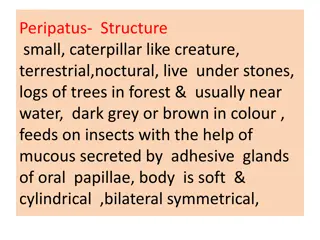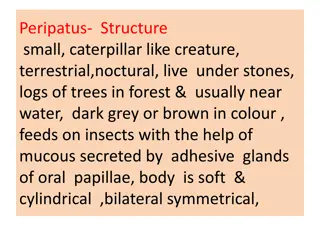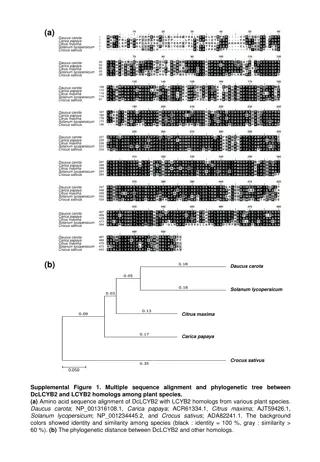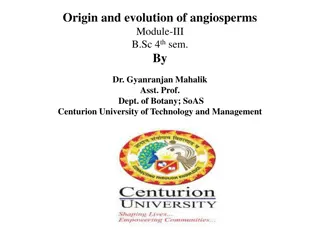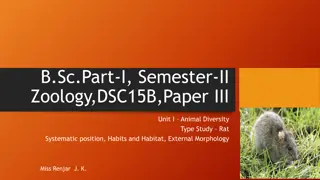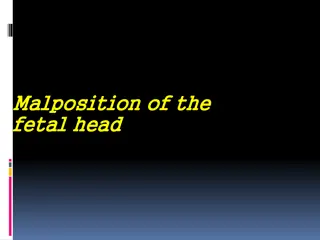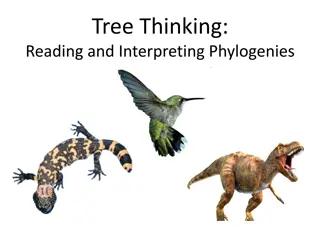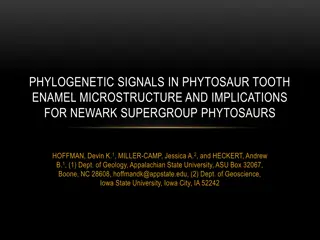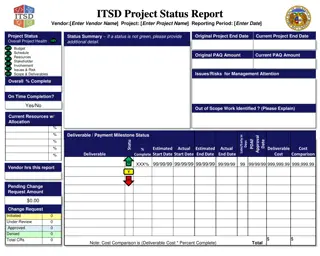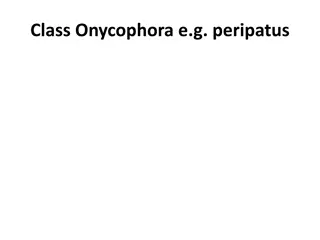Phylogenetic Status of Peripatus: Exploring its Systematic Position
Peripatus, known as claw bearers, exhibits characteristics of both annelids and arthropods, making it an intriguing species in the study of evolutionary biology. Considered as an intermediate link between these two phyla, Peripatus raises questions about its classification and evolutionary history. While some propose its inclusion within Arthropoda, others argue for its distinct position as a separate phylum with unique characteristics. The discovery of fossil evidence further adds complexity to understanding the phylogenetic status of Peripatus.
Download Presentation

Please find below an Image/Link to download the presentation.
The content on the website is provided AS IS for your information and personal use only. It may not be sold, licensed, or shared on other websites without obtaining consent from the author. Download presentation by click this link. If you encounter any issues during the download, it is possible that the publisher has removed the file from their server.
E N D
Presentation Transcript
Phylum Onychophora P Vinod PG Department of Zoology
Triploblastic, bilaterally symmetrical Thin cuticle composed of chitin Body has anterior head & posterior trunk Tagmosis : grouping of body segments into similar regions, similar functions, and similar appendages Head has 3 pairs of appendages Body cavity has bood (open type) Heart lies in pericardial sinus Repiration through air filled tracheae Excretion through paired nephridia Nervous system has dorsal brain and ventral nerve cords Sensilla and eyes are sensory Body wall has many papillae Sexes separate and sexually dimorphic Viviparous Considered as living fossil because the living members appear similar to fossil species as much as 570 million years old
Peripatus (claw bearers) Nocturnal, living in moist & shady regions in forests (2 8 cm long body) Feeds on small insects Body soft, elongated and vermiform segmented Head consists of 3 segments carrying 3 pairs of appendages, a pair of simple eyes & a mouth. Anterior segment carries preantennae which bears many rings of tubercles 2ndsegment bears 2 claw-like jaws (mandibles) 3rdsegment are a pair of oral papillae Trunk has many wrinkles or annuli Each annulus bears numerous conical tubercles and they end in chitnous spines Each trunk segment carries a pair of ventro-lateral walking legs which is outgrowth of body wall Foot ends in a pair of claws Coxal organs, anus, etc lies at ventral side A tube heart present in pericardinal sinus and opens into pericardial cavity through ostia Stigmata are openings of body surface through which tracheal tubes open for respiration Nephridiopores at the bases of legs are openings of nephridia for excretion A pair of oval ganglia in head and double ventral nerve cord comprises nervous system Peripatus is gonochoric and development without any larva
Comment on the phylogenetic status of Peripatus./Discuss on the systematic position of Peripatus. Peripatus have both annelidan & arthropodan characteristics. Therefore they are regarded to be intermediate stage or connecting link between Annelida & Arthropoda. However they appear to be more closely allied to arthropods than to annelids. They may represent an offshoot from near the base of the arthropod line. Based on such phylogenetic considerations, Manton & other contemporary zoologists have included onychophorans (Peripatus) within the Arthropoda as a subphylum or class. But absence of exoskeleton, & jointed limbs & the presence of primary annelid characters in Onychophora create serious problems. In fact, onychophorans are neither annelids nor arthropods but possess distinct characteristics of their own. Hence now a days, Onychophora is considered as a separate phylum. The modern view holds that Onychophora is not an evolutionary link between Annelida & Arthropoda but a distinct surviving branch. This is supported by the discovery of a mid-Cambrian fossil, Aysheaia which closely resembles the modern Onychophora.
Arthropod characters of Onychophora Presence of antennae. Body is covered with chitinous cuticle. Appendages are provided with claws. Jaws are modified appendages, provided with striped muscles. Locomotion by definite legs having definite musculature. Presence of haemocoel. Dorsal tubular heart with lateral ostia. Presence of tracheal respiratory system. Coelom reduced to small cavities that surround the excretory & reproductive ducts. Peculiar salivary gland supposed to be modified nephridia. Brain is large & typically arthropodan. General structures of the reproductive organs & development mainly arthropodan.
Annelid characters of Onychophora Vermiform body with truncated extremities. Absence of true head. Outer body covering is cuticle, skin thin & flexible. Muscles separate in identical way. locomotion slow & by peristalsis as in an earthworm. Simple & straight alimentary canal. Paired, segmentally arranged nephridia. Presence of cilia in excretory & reproductive ducts. Structure of eye same as in polychaetes. Slime & coxal glands correspond with similar glands of chaetopods.
Onychophoran characteristics Body shows no or indistinct segmentation. Texture of skin. A rough cuticle covered with numerous velvety processes not known in other phyla. Antennae not homologous to the antennae of other arthropods. 3 segmented head of Peripatus shows a condition mid way between that of Annelida & Arthropoda. Restriction of jaws to a single pair. Movement of jaws is antero- posterior. Presence of non jointed legs with claws. Irregular distribution of spiracles or tracheal openings. 2 ventral nerve cords widely separated & without true ganglia. Structure of eye less complicated. Distribution of reproductive organs.
Make a note on the geographical distribution of Peripatus The genus Peripatus is found restricted in various places of world such as South America & West Indies, South Africa, Australia, New Zealand, Tasmania, New Britain, , Malaya, Equatorial Africa & Chile. Some common forms of Peripatus are:- Neo-Peripatus:- (Peripatus):- West Indies & America Congo-Peripatus:- (Mesoperipatus Evans):- Congo & Caribbean islands. Eo-Peripatus:- (EoperipatusEvans):- Malaya Capo-Peripatus:- (including Peripatopsis Pocock & Opisthopatus Purcell):- South Africa Melano-Peripatus;- ( Paraperipatus Willey):- New Britain. Austro-Peripatus:- (Peripatoides Pocock & Ooperipatus Dendy):- Australia, Tasmania, New Zealand. Chilio-Peripatus:- (Opisthopatus Bouvier), Chile.









